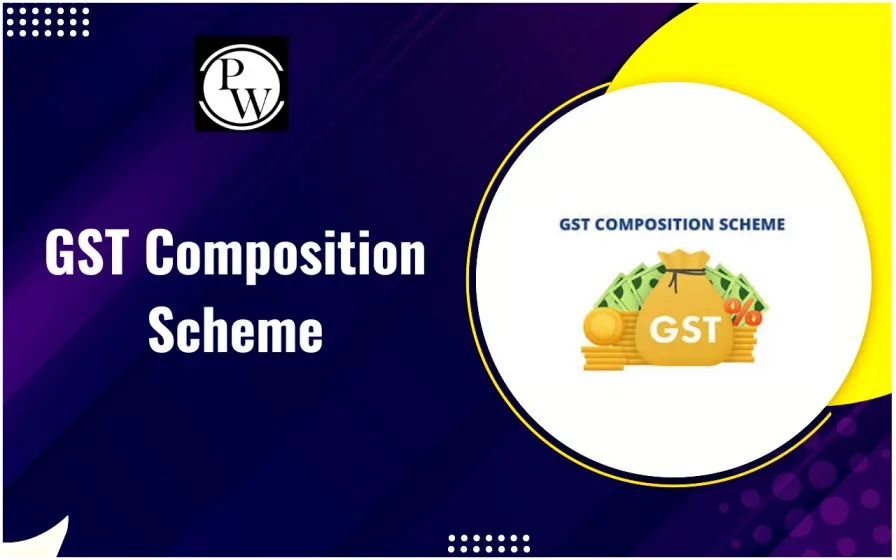
The GST Composition Scheme offers a simpler way to handle their taxes under the Goods and Services Tax system. It’s tailored for those who struggle with the often complicated process of filing GST returns and making tax payments. Instead of sticking to the usual GST rates, businesses enrolled in this scheme pay a fixed tax rate that’s determined by their turnover. This approach not only simplifies the taxation process but also helps improve cash flow for these businesses.
Below, we will understand the details of the GST Composition Scheme, covering its rules, turnover limits, tax rates, and the benefits it brings.
The GST Composition Scheme offers an easier tax payment method for small taxpayers. Rather than paying tax on every sale and submitting various returns, individuals in this program remit a set percentage of their gross income as tax. It is a voluntary program intended to lessen the compliance load for small businesses.
For instance, if a producer’s yearly revenue amounts to Rs 1 crore, they will be charged GST at a standard rate of 1% instead of computing tax for every sale transaction.
Before choosing the GST Composition Scheme, it is important to understand the basic requirements that determine who can opt for the Composition Scheme:
Turnover Limit: This scheme is available only to businesses that have annual sales within a specific limit, which is up to Rs 15 lakh or Rs 18.75 Lakh for special category states.
Nature of Business: It’s open to suppliers of goods and certain services, but not for those engaged in inter-state sales, supplying non-taxable goods, or those who fall under Reverse Charge provisions.
No Input Tax Credit: Businesses participating in this scheme won’t be able to claim input tax credit on their purchases or operational expenses.
Simplifies Compliance: Participants benefit from less paperwork, fewer returns filings, and easier record keeping
Tax Rate: Instead of the usual GST rates, a fixed, lower percentage rate of total turnover is applied as tax.
Quarterly Payment: Taxes are settled every quarter, which helps in managing cash flow more efficiently.
Voluntary Opt-in: Businesses can voluntarily choose this scheme if they meet the eligibility criteria and adhere to the necessary procedure.
The turnover limits for the GST Composition Scheme determine the eligibility for opting into this scheme. The limits are:
For Producers and sellers: Rs 1.5 crore
For Restaurants (without offering alcoholic beverages): Rs 1.5 crore
For Service providers: Rs 50 lakhs
For states in the special category: Rs 75 lakhs
If the turnover exceeds these limits in the financial year, then the taxpayer needs to transition to the standard GST Scheme.
The GST Composition tax rate for 2025 is reduced in comparison to the standard GST Rates. The charges are:
Producers and sellers: 1% of revenue(0.5% CGST+0.5%SGST)
Restaurants(Non-alcoholic): 5% of revenue(2.5%CGST+ 2.5% SGST)
Service Providers: 6% of revenue(3% CGST+ 3%SGST)
These figures are simple to determine and assist companies in managing their finances more effectively.
Companies must meet certain criteria to be eligible for this program. The qualifications for the GST Composition Scheme consist of:
Businesses with an annual turnover below 1.5 crore. 75 lakhs for the North-Eastern states and Himachal Pradesh
According to the CGST (Amendment Act, 2018), service providers with revenue up to 50 lakhs are allowed a composition dealers to provide services amounting to 10% of their turnover or Rs 5 lakh, or the greater amount
However, companies engaged in inter-state transactions, e-commerce providers, and distributors of restricted products such as tobacco, ice cream, or pan masala are ineligible to register for this scheme.
The GST composition rules and conditions are simple, but must be followed carefully:
Businesses can apply online through the GST portal by following these detailed steps:
Step 1: Visit the official GST portal and log in with your username and password.
Step 2: Navigate to Services > Registration > Application to opt for composition levy.
Step 3: Read the terms and conditions carefully, check the declaration box, and proceed.
Step 4: Fill in all required details, such as business information, turnover, and place of business.
Step 5: Review the details entered and submit the form using e-signature, Electronic Verification Code (EVC), or Digital Signature Certificate (DSC).
Step 6: After submission, you will receive an acknowledgment reference number for tracking the application.
The advantages of the GST Composition Scheme for small businesses are considerable and can simplify tax management considerably:
The tax rates are reduced, which contributes to lowering the total tax load and enhances profit margins
Filing returns is easier, since businesses are required to submit quarterly returns rather than monthly ones.
Cash flow enhances as taxes are settled less often and at a consistent rate, simplifying fund management
The record keeping required is less extensive than in the standard GST system, reducing both time and effort in managing intricate accounts
Although the program has many advantages, it also has certain drawbacks that must be taken into account:
Input Tax Credit(ITC) cannot be claimed, which indicates that businesses are unable to reduce the GST incurred on their acquisition
Inter-state sales are prohibited, which restricts the extent of businesses functioning in various states
Regular taxpayers may steer clear of sellers under the composition scheme, as they are unable to claim ITC on those purchases, potentially limiting B2B sales chances.
Taxpayers under this scheme must file:
GSTR-4: Quarterly Return
GSTR-9A: Annual Return
The GST Composition Scheme offers a simple, budget-friendly, and effective tax choice for small enterprises. Understanding the GST Composition Scheme Turnover Limit, GST Composition Tax Rate for 2025, and the eligibility criteria for the GST Composition Scheme enables businesses to make informed decisions. By comprehending the GST Composition Rule and Conditions, small business owners can conserve time and concentrate on expanding their business
| Related Links | |
| CSEET | CSEET Registration |
| CSEET Exam Date | CSEET Syllabus |
| CSEET Exam Pattern | CSEET Admit Card |
| CSEET Result | CSEET Preparation |
| CSEET Eligibility Criteria | CSEET Exam Centres |
